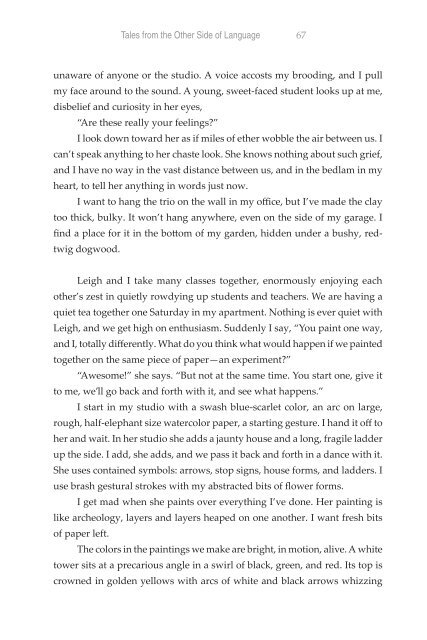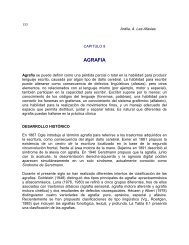the PDF of her book - National Aphasia Association
the PDF of her book - National Aphasia Association
the PDF of her book - National Aphasia Association
Create successful ePaper yourself
Turn your PDF publications into a flip-book with our unique Google optimized e-Paper software.
Tales from <strong>the</strong> O<strong>the</strong>r Side <strong>of</strong> Language 67<br />
unaware <strong>of</strong> anyone or <strong>the</strong> studio. A voice accosts my brooding, and I pull<br />
my face around to <strong>the</strong> sound. A young, sweet-faced student looks up at me,<br />
disbelief and curiosity in <strong>her</strong> eyes,<br />
“Are <strong>the</strong>se really your feelings?”<br />
I look down toward <strong>her</strong> as if miles <strong>of</strong> e<strong>the</strong>r wobble <strong>the</strong> air between us. I<br />
can’t speak anything to <strong>her</strong> chaste look. She knows nothing about such grief,<br />
and I have no way in <strong>the</strong> vast distance between us, and in <strong>the</strong> bedlam in my<br />
heart, to tell <strong>her</strong> anything in words just now.<br />
I want to hang <strong>the</strong> trio on <strong>the</strong> wall in my <strong>of</strong>fice, but I’ve made <strong>the</strong> clay<br />
too thick, bulky. It won’t hang anyw<strong>her</strong>e, even on <strong>the</strong> side <strong>of</strong> my garage. I<br />
find a place for it in <strong>the</strong> bottom <strong>of</strong> my garden, hidden under a bushy, redtwig<br />
dogwood.<br />
Leigh and I take many classes toge<strong>the</strong>r, enormously enjoying each<br />
o<strong>the</strong>r’s zest in quietly rowdying up students and teac<strong>her</strong>s. We are having a<br />
quiet tea toge<strong>the</strong>r one Saturday in my apartment. Nothing is ever quiet with<br />
Leigh, and we get high on enthusiasm. Suddenly I say, “You paint one way,<br />
and I, totally differently. What do you think what would happen if we painted<br />
toge<strong>the</strong>r on <strong>the</strong> same piece <strong>of</strong> paper—an experiment?”<br />
“Awesome!” she says. “But not at <strong>the</strong> same time. You start one, give it<br />
to me, we’ll go back and forth with it, and see what happens.”<br />
I start in my studio with a swash blue-scarlet color, an arc on large,<br />
rough, half-elephant size watercolor paper, a starting gesture. I hand it <strong>of</strong>f to<br />
<strong>her</strong> and wait. In <strong>her</strong> studio she adds a jaunty house and a long, fragile ladder<br />
up <strong>the</strong> side. I add, she adds, and we pass it back and forth in a dance with it.<br />
She uses contained symbols: arrows, stop signs, house forms, and ladders. I<br />
use brash gestural strokes with my abstracted bits <strong>of</strong> flower forms.<br />
I get mad when she paints over everything I’ve done. Her painting is<br />
like archeology, layers and layers heaped on one ano<strong>the</strong>r. I want fresh bits<br />
<strong>of</strong> paper left.<br />
The colors in <strong>the</strong> paintings we make are bright, in motion, alive. A white<br />
tower sits at a precarious angle in a swirl <strong>of</strong> black, green, and red. Its top is<br />
crowned in golden yellows with arcs <strong>of</strong> white and black arrows whizzing



